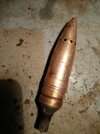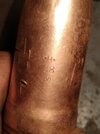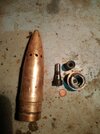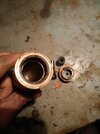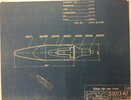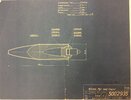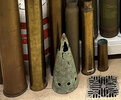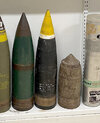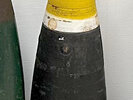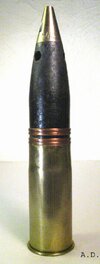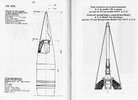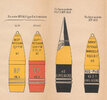British Ordnance Collectors Network
You are using an out of date browser. It may not display this or other websites correctly.
You should upgrade or use an alternative browser.
You should upgrade or use an alternative browser.
Bofors projectile ID
- Thread starter MINENAZ16
- Start date
wingsofwrath
Well-Known Member
That's a mighty interesting design and I can see what the thought process was, to create something that is at the same time a driving band and an aerodynamic nosecone, but I'm assuming it also worked poorly in practice and was quickly abandoned, because I can also see a few ways this could have gone that way - for example if the copper sheath isn't exactly straight on the shell body or if it's too thick on one side, it will absolutely cause it to wobble in the barrel and create all kinds of amusing gyroscopic effects in flight. Also, copper is very expensive compared to steel.
Also, I'm not sure, but the body itself looks very much like a 37mm Bofors, so it might be possible the thinking was to reuse the same casting but to bulk it up to 40mm with that combination driving band/bourrelet/nosecone.
I'm also not sure how they thought to secure the sheath to the body against rotation, because while I see a crimping groove with some vertical crimps in it as well, I'm not sure that's enough.
Finally, the holes - since there are holes in the fuze as well, could that be demilling?
Also, I'm not sure, but the body itself looks very much like a 37mm Bofors, so it might be possible the thinking was to reuse the same casting but to bulk it up to 40mm with that combination driving band/bourrelet/nosecone.
I'm also not sure how they thought to secure the sheath to the body against rotation, because while I see a crimping groove with some vertical crimps in it as well, I'm not sure that's enough.
Finally, the holes - since there are holes in the fuze as well, could that be demilling?
Spaceinvader
Well-Known Member
There is a thread on the International Ammunition Association on near identical projectiles, they also feature the holes in the caps so it is likely original and nothing to do with demilling as the projectiles had a live HE inside.
Not to make any assumptions, but the nose is similar to some of the much larger US Navy rounds that contain a dye pack to identify impact locations and which gun fired which round. Note the pale green windshield from an 8-inch AP and the 6-inch AP just below the white band.
Attachments
wingsofwrath
Well-Known Member
Hmm. Since I deal mostly in land artillery, I hadn't thought of dye packs, but I must ask - what would be the usefulness of having a dye pack in a very small shell which also has a tracer? Because if it's just a bit of paint, it might not colour the splash enough for it to matter, and, in any case, you already know where it went because of the tracer.
The only other shells that I know of with holes in the ogive are French WW1 incendiary tracers, especially the 37mm "Obus en acier du type D Traceur-incendiaire d'aviation" (Steel shell D-type tracer-incendiary for aircraft) which was used by French aircraft against balloons and dirigeables. It was filled with a mixture of 90% red oxide and 10% powdered magnesium, with a starting charge of superfine (F3) black powder, the whole lot secured by a thin disc of tin. Ignition was either because of the concussion nose fuze which functioned on firing and/or by hot gases from the firing entering through the holes - the literature is a bit fuzzy on that one.
However, I'm pretty sure it would make just as little sense to have the incendiary mixture of an AP shell that's supposed to go through armour in the nose cone, making sure it gets smashed to bits before the armour gets penetrated, so at this point I must admit I'm stumped.
The only other shells that I know of with holes in the ogive are French WW1 incendiary tracers, especially the 37mm "Obus en acier du type D Traceur-incendiaire d'aviation" (Steel shell D-type tracer-incendiary for aircraft) which was used by French aircraft against balloons and dirigeables. It was filled with a mixture of 90% red oxide and 10% powdered magnesium, with a starting charge of superfine (F3) black powder, the whole lot secured by a thin disc of tin. Ignition was either because of the concussion nose fuze which functioned on firing and/or by hot gases from the firing entering through the holes - the literature is a bit fuzzy on that one.
However, I'm pretty sure it would make just as little sense to have the incendiary mixture of an AP shell that's supposed to go through armour in the nose cone, making sure it gets smashed to bits before the armour gets penetrated, so at this point I must admit I'm stumped.
Attachments
wingsofwrath
Well-Known Member
Are they for aerodynamic purposes though? Because I always assumed the holes in the windshield of the 155mm FATO were for screwing it on after fuzing the projectile. After all, the fuze is under the ballistic cap, only some diagrams show those holes and even then they only show one.Ballistic cap of french 155mm FATO is also drilled.
I assume something to do with the wind in flight
Attachments
You can see holes in the cap here : https://www.bocn.co.uk/threads/it-i...-fato-shell-ballistic-cap.108315/#post-335400
wingsofwrath
Well-Known Member
Thank you, never seen an actual picture of the 155mm FATO before, and somehow missed that topic on BOCN when it came out.
Ok, it does look like the holes on both projectiles might be aerodynamic.
Ok, it does look like the holes on both projectiles might be aerodynamic.

